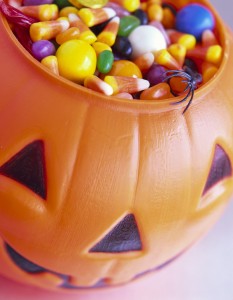 Halloween is an interesting holiday to say the least. Kids dress up in costumes anywhere from witches to princesses and from superman to zombies. Then, we as parents encourage them to do something that we are opposed to them doing the rest of the 364 days a year – accept candy from strangers. Nonetheless, it is fun to see our kids dressed in cute little costumes as they run around the neighborhood excitedly collecting treasures of sugary goodness.
Halloween is an interesting holiday to say the least. Kids dress up in costumes anywhere from witches to princesses and from superman to zombies. Then, we as parents encourage them to do something that we are opposed to them doing the rest of the 364 days a year – accept candy from strangers. Nonetheless, it is fun to see our kids dressed in cute little costumes as they run around the neighborhood excitedly collecting treasures of sugary goodness.
Once the fun of collecting candy is over, parents must now deal with the consequences of trick or treating – the plunders of their children’s hard earned efforts. Some parents react to their children’s earnings by electing themselves to the Government of Candy Distribution and tax their children 100%. They repossess the candy their kids bring home, and then judiciously redistribute the candy on a per diem basis for the next several months. Although, this parental reaction is logical, it may send the message to children that parents must regulate their children eating because children are unable to regulate themselves.
One of the basic principles taught in the Love and Logic Parenting Curriculum is looking forward to our kids making mistakes. By allowing our kids to make mistakes, showing empathy, being there for them as they experience the consequences of their mistakes, and then allowing the consequences to do the teaching followed by giving kids the opportunity to succeed or fail again, we send the message that our kids can learn from their mistakes and they can make better choices in the future.
Rather than taking your kids candy away and then giving it back to them bits at a time for the rest of eternity, some parents allow their kids to keep all of their candy. Parents may say something like, “Wow, it looks like you got a lot of really yummy candy. Can I have a piece? I just want one though, because when I eat too much candy at one time, my stomach starts to hurt, sometimes my head hurts too, and I don’t feel well after a while. I hope you enjoy your candy.” Then these parents will allow their kids to eat as much of their candy as they want. After a while, when their child is either sick or acting crazy, the parent will bring their child in close and ask how the child is feeling. With empathy the parent might say, “That is how I feel when I eat too much candy too.”
Other parents present their kids with a choice of keeping and eating their candy or trading it all in for a small toy. I’ve know some parents who make it fun by telling their kids that they can put their candy in a large bowl and leave it out before they go to bed on Halloween night and the Halloween Goblin will come by and take it and leave a toy in its place.
The benefit of using one of these techniques, other than sharing control and helping kids learn how to regulate themselves instead of depending upon their parents to do it for them, is that the candy either gets eaten faster or thrown away quicker. This makes it so the parents don’t have to keep the candy hidden up on a shelf and then get angry with kids when the kids sneak their candy when the parents aren’t looking.
Of course if your child is diabetic or too young to understand the concept that food can make them feel good or bad, it may be necessary for a parent to be in charge of regulating the amount of candy that their children eat. For young kids under the age of 4, it might be wise to limit how many homes they go to while they trick or treat.
Thanks for reading. You may find the parenting tip on teeth brushing an appropriate follow up to this parenting tip.
 Shiloh Lundahl, LCSW, is a child and family therapist in Gilbert and Mesa, Arizona. He is the founder of Parent Arizona and Counseling Services and is part of the Arizona Family Institute.
Shiloh Lundahl, LCSW, is a child and family therapist in Gilbert and Mesa, Arizona. He is the founder of Parent Arizona and Counseling Services and is part of the Arizona Family Institute.
He provides parenting classes using the Love and Logic curriculum, classes for parents of children with ADHD, step-parenting classes, and advanced trainings for foster and adoptive parents. He also provides in-home therapy in Gilbert, Mesa, Queen Creek, San Tan Valley, Chandler, and Tempe, Arizona.
